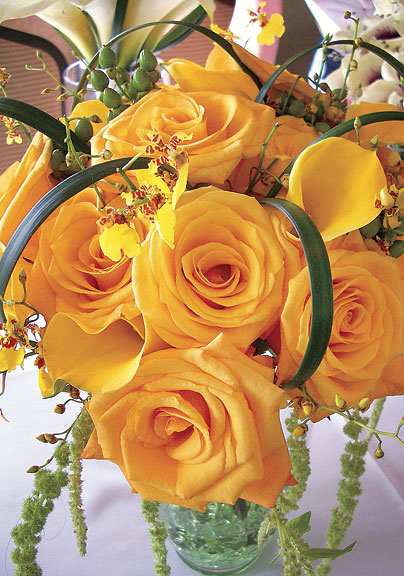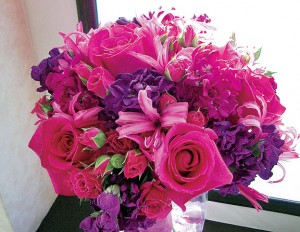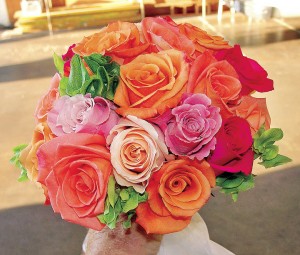Bridal Blooms — Custom wedding floral design personalizes the big day
By Karen Dix
April 2012 View more Featured
 Weddings are a feast for the eyes, and the flowers are a main course—deliciously adorning the people and places involved in the glorious event. “Some brides even pick their flowers before their dress if flowers are important to them,” says Andrew Parravano of Andrew’s Garden, a boutique floral designer and wedding specialist. Each couple determines the role of flowers at their own wedding, with many forgoing the standard “out of a book” arrangements to instead work with a floral designer to create pieces that artistically express their life and love.
Weddings are a feast for the eyes, and the flowers are a main course—deliciously adorning the people and places involved in the glorious event. “Some brides even pick their flowers before their dress if flowers are important to them,” says Andrew Parravano of Andrew’s Garden, a boutique floral designer and wedding specialist. Each couple determines the role of flowers at their own wedding, with many forgoing the standard “out of a book” arrangements to instead work with a floral designer to create pieces that artistically express their life and love.
Bloomin’ Budgets
Designers strive to provide custom arrangements within a budget, which is usually about 10 percent of the average total wedding budget, or a minimum $4,500. This would cover all bouquets and boutonnieres, decorations for the venue and the reception hall, table centerpieces, and other arrangements. Carol Sawka of O’cie Floral, an award-winning wedding floral specialist and event coordinator, reminds brides that weddings are not just “one day.”
“There’s the rehearsal dinner and often a wedding brunch the next day. Flowers can have a place at any of the venues, and even be moved to serve more than one function,” she says.
Of course, a bride’s budget and venue will determine her choices. Outdoor wedding budgets are usually higher, since flowers are used to frame the venue. The bride with a generous budget may choose tall, elaborate arrangements, or artistic groupings of two or three centerpieces on the head or reception table. Common splurges on premium flowers, in and out of season, like exotic orchids, hydrangeas, and tulips, can cost up to $20 a stem.
For brides whose taste is more extravagent than their budget, Sawka offers three solutions: Settle for arrangements within the budget; realllocate the wedding budget to include more for flowers; or, as a last resort, reduce the places where flowers will be used. Using “stock” in-season, rather than premium, blooms also can hold down costs. Phillips Flowers and Gifts, a third-generation wedding florist, operates its own wholesale warehouse that offers brides a large selection at competitive prices. “It’s important to determine what’s really important to the couple and make sure it’s included in the wedding,” says Phillips Wedding Floral Designer Brad Behrens.“We can add on from there.”
Seeds of Collaboration
 Next, couples should ideally have a style in mind at their first meeting with the florist, which should take place at least nine months before the wedding. “We encourage them to bring in photo clippings of things they like,” says Behrens. “It’s usually not that they don’t know what they want, they just don’t know how to communicate it. It’s also helpful to have a swatch from the bridesmaid dresses, linens, or centerpiece items to match color and feel for the design.”
Next, couples should ideally have a style in mind at their first meeting with the florist, which should take place at least nine months before the wedding. “We encourage them to bring in photo clippings of things they like,” says Behrens. “It’s usually not that they don’t know what they want, they just don’t know how to communicate it. It’s also helpful to have a swatch from the bridesmaid dresses, linens, or centerpiece items to match color and feel for the design.”
Parravano gives brides a long list of adjectives like “elegant,” contemporary,” “whimsical,” “fairytale,” “retro,” etc., and asks them to choose three to describe their wedding. “Usually a theme or a pattern comes through that helps us begin creating the right mood. Or they bring in something sentimental they want included in the wedding and we work from that,” he says.
When it’s time to start creating, the experts actively involve the couple in order to fulfill their creative vision. “I like to take them to the wholesaler about two months before the wedding to select the type of flowers they like,” says Parravano. Each designer offers to work alongside the couple to create sample pieces in their studios or on-site at the venue.
Growing Trends
Less is More
In today’s economy, designers say more people are watching their budget and cutting the guest list. “Couples find they can make the event more meaningful and personal if the wedding is smaller,” Sawka says.
Vintage
Brides embrace a throwback to the Hollywood glamour of the ‘30s and ‘40s or a Victorian style wedding, featuring soft, romantic tones and traditional wedding flowers like roses and calla lilies. They often incorporate something antique or historical into the floral design, such as grandma’s brooch or handkerchief.
Bling
Many brides still like sparkle, with plenty of pearls, sequins, or rhinestones. “They may want a simpler bouquet that doesn’t fight with the dress,” says Sawka, “or some want more sparkle.” Designers will wrap bouquets with jewel-studded material or incorporate jewels into the actual arrangement.
The “Out of the Garden” Look
 With a nod toward the ever-popular green movement, many brides choose casual, natural looking arrangements of “backyard” types of flowers—like sunflowers, daisies, garden roses, sedum, succulents, and even fruits—particularly for outdoor weddings. Arrangements feature homey, recycled items like antique milk jugs, mason jars, and clay pots to add a rustic, old-fashioned feel to the event.
With a nod toward the ever-popular green movement, many brides choose casual, natural looking arrangements of “backyard” types of flowers—like sunflowers, daisies, garden roses, sedum, succulents, and even fruits—particularly for outdoor weddings. Arrangements feature homey, recycled items like antique milk jugs, mason jars, and clay pots to add a rustic, old-fashioned feel to the event.
Personal Dramatic Effect
Couples incorporate their personal tastes into their floral design, like the well-traveled couple that asked Sawka to represent a different country at each reception table. She spent hours researching international flowers to create appropriate centerpieces. Another bride, a “Tim Burton” fan, asked Parravano to transform the hall into an “elegant forest,” which he did by hanging votive candles from stark, tree-like centerpieces on each table. “Doing something a little unexpected, like adding black ostrich plumes to a white bouquet, adds a sense of drama to the event,” said Parravano.
Styles and Colors
Designers say the sleeveless sheath wedding dresses are leaving and being replaced by flowing, romantic gowns with lace and sleeves, somewhat an influence from the recent royal wedding. As far as colors go, Behrens says, “I’m seeing a strong trend toward the purple tones,” and Sawka sees a return of earthier tones like gray and brown with “navy becoming the new black.” Parravano sees a trend toward bright, hot colors, complimenting more exotic blooms in the wedding arrangements.
Non-Tradition
All the designers encourage the individuality of the couple to shine through in their choices. Generations of families have used Phillips as their wedding florist, yet Behrens says brides rarely ask for repeat performances. “It’s not your mother’s wedding anymore,” he says. “It’s yours.”
Photos courtesy of Phillips Flowers

